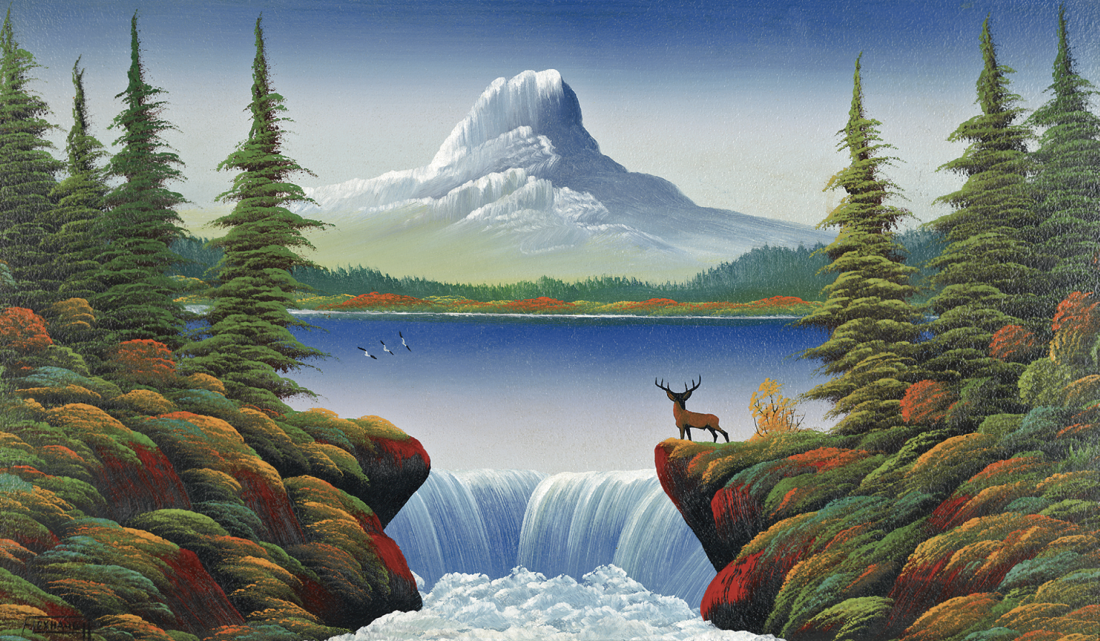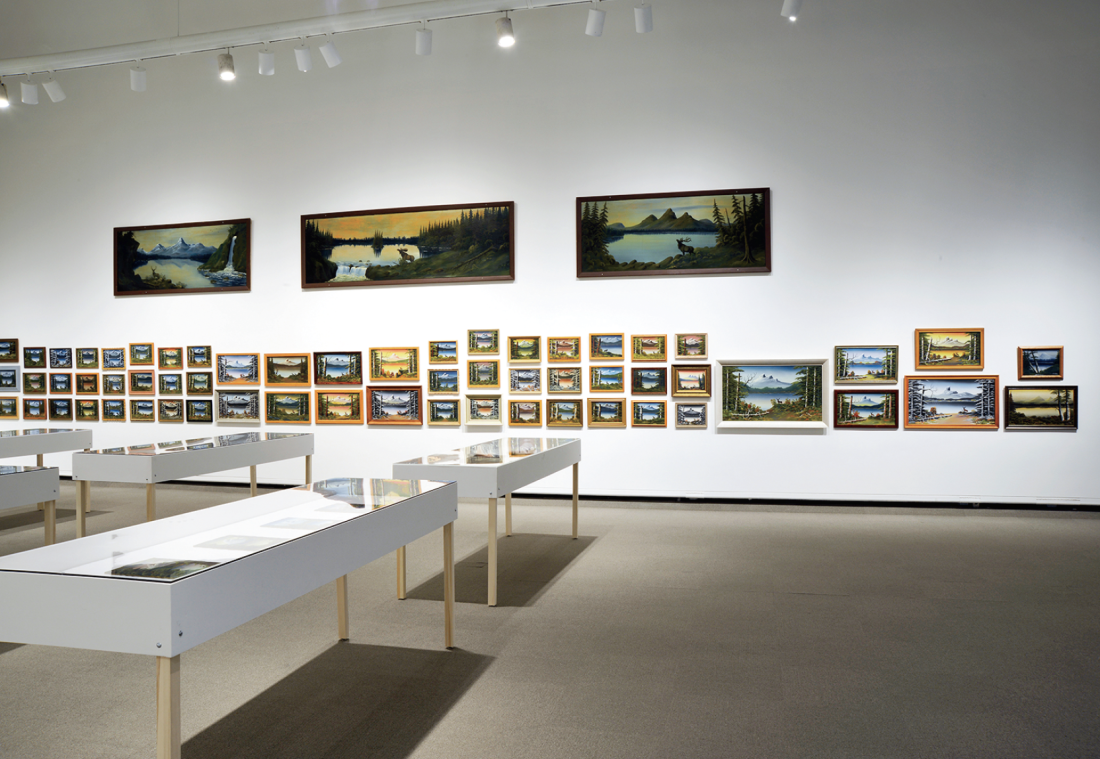Levine Flexhaug
I grew up in a house on the Prairies peppered with landscape paintings, but I didn’t see my first Flexi until after I started art school. Levine Flexhaug, an itinerant painter from Climax, Saskatchewan, was not part of the curriculum. Rather his paintings were weekend thrift-store finds sought after by artists, museum curators and collectors. Paintings from 34 public and private collections including those of painters Chris Cran, Rick Gorenko and David Thauberger comprise the 465 paintings on display in “A Sublime Vernacular: The Landscape Paintings of Levine Flexhaug,” a touring exhibition organized by the Grande Prairie Regional Art Gallery co-curated by Nancy Tousley and Peter White. In addition, Tousley and White commissioned Calgary filmmakers Gary Burns and Donna Brunsdale to produce a feature film and 20-minute exhibition short, which further contextualize this collection of collections. Flexie! All the Same and All Different unearths the power and the persistence of landscape in our imaginations to question its significance to Canadian art and identity. The films, like the show, ask why people collect Flexis; how they are valued; and how they can be situated in the world of art.
Levine Flexhaug (1918–1974) carved out a living for his family as a painter on the Prairies during the 30 years following the Dust Bowl and the Depression. He was self-taught, and when not at the kitchen table, painted in The Bay’s paint and furniture departments, at cafes and summer resorts like Clearwater Lake, Saskatchewan. All but a few of the later western-themed works are imagined but similarly constructed familiar landscapes: a mountain or grassy knoll in the background, a lake applied alla prima to the middle ground and a foreground with an animal, cabin, fence or cascade curtained by trees. Painted in a matter of minutes, and often more than one at a time, each small oil-based house paint on beaverboard panel cultivates an idea of rural Eden that could be purchased for only a few dollars. For the regional buyers these speed-paintings functioned as souvenirs, an escape, while now they are nostalgic signs of a dedicated painter working in simpler times.

Levine Flexhaug, Untitled (Mountain lake with deer, waterfall and three birds), date unknown, oil-based house paint on beaver board, 25.5 x 60.4 cm. Collection of David and Veronica Thauberger, Regina, Saskatchewan. Photograph MN Hutchinson. Courtesy MacKenzie Art Gallery, Regina.
Tousley and White share an interest in the circulation and value of images in culture, which is what “A Sublime Vernacular: The Landscape Paintings of Levine Flexhaug” displays. The exhibition is a taxonomy of Flexi’s prolific production organized by type—blasted trees, animal sentinels, split-rail fences, cascades, huts—landscape tropes that have circulated in high art and popular culture since early Romanticism. Hung in a rigidly gridded Salon style above a continuous three-foot horizon line, the exhibition design stresses repetition and difference within and between each category. This display strategy repeats the internal logic of Flexi’s compositions, and makes it all but impossible to consider a singular work outside its relationship to the whole collection. Each painting is the same but different; each is an original but also a copy of the others.
Tousley’s catalogue essay convincingly speculates that Flexi’s highly conventionalized landscapes relate to the Picturesque, a European aesthetic movement of 18th-century poets and painters who crafted a cultured vision of nature between the Sublime and the Beautiful. Flexi’s speed paintings are steeped in artifice, likely exaggerated by generations of selective refinement and reproduction of landscape’s semiotic devices. Tousley notes even his techniques, particularly Flexi’s brushstrokes, borrow from diverse sources he likely encountered: Norwegian ornamental art that travelled from Minnesota northwest to the Prairies; other itinerant painters like Cowboy Joe Breckenridge (1894–1972); and commercial sign painting. The modified salon installation stresses his ubiquitous technique through pattern and repetition. Yet on closer inspection what seems the same is revealed as qualitatively different from unique frame to frame.

Installation view, “A Sublime Vernacular: The Paintings of Levine Flexhaug,” MacKenzie Art Gallery, Regina, May 23 to August 9, 2015. Photograph Don Hall. Courtesy MacKenzie Art Gallery.
Flexi’s imagery demonstrates how cultural signs filter down from high art into popular culture and sometimes back again. Often this happens through mechanical reproduction, photography, print and film, and always through art history, the market and its institutions. “A Sublime Vernacular” refers as much to these constructs of the hierarchies of taste as it does to the language of the paintings themselves. The paintings bridge high art and kitsch and become the perfect vehicle to question the assumptions of taste and power art institutions reinforce, rather than challenge. This project recalls Komar and Melamid’s The People’s Choice, 1998–2000, which also showed at the Illingworth Kerr Gallery, and exhibited the most wanted and most unwanted paintings based on public opinion polls from countries around the world. Yet it maintained an ironic distance that is not so easily discernable in the Flexi show. Instead Tousley and White’s Flexi exhibition, catalogue and website are sincere documents and critical explorations of the art, artist and art world in which he exists.
The conceptual curatorial frame is stronger for its seriousness. It makes us question even more why these paintings feel so out of place at the IKG. The exhibition was received as an affront to many at the Alberta College of Art + Design. Some could not move past a formal modernist evaluation of the singular object to look at the object in context and to understand the exhibition as a cultural object itself. Compounding the unease, some of the nostalgic artist-farmer collector narratives clearly puncture any disinterested aesthetic view. Situated by its display between art and artifact, between high art and popular art, “A Sublime Vernacular: The Landscape Paintings of Levine Flexhaug” unsettles institutional and art market hierarchies and this project becomes highly relevant to anyone interested in the study of material culture. ❚
“A Sublime Vernacular: The Landscape Paintings of Levine Flexhaug” was organized by the Art Gallery of Grande Prairie, Grand Prairie, Alberta, and was exhibited at MacKenzie Art Gallery, Regina, from May 23 to August 9, 2015; at Illingworth Kerr Gallery, Alberta College of Art and Design, Calgary, from October 29 to December 5, 2015; and will be on exhibition in 2016 at the Art Gallery of Grande Prairie, Grande Prairie, Alberta and in 2017 at Rodman Hall Art Centre, St. Catharines, Ontario, and Contemporary Art Gallery, Vancouver.
Diana Sherlock is a Canadian independent curator and writer who teaches critical theory and professional practice in the School of Critical + Creative Studies at the Alberta College of Art + Design.

